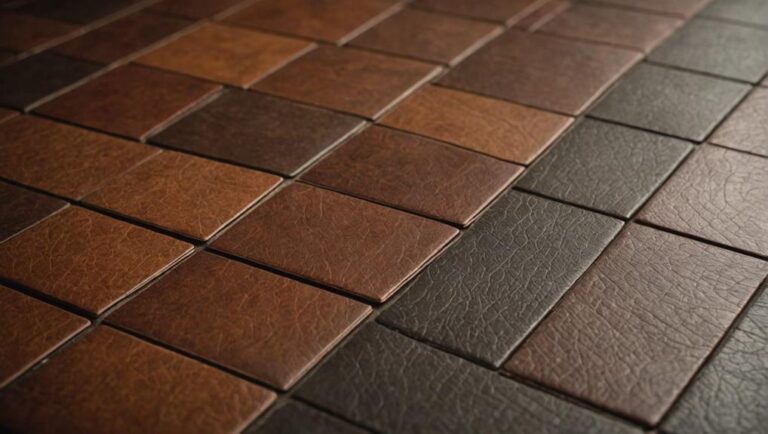To patch vinyl and laminate flooring effectively, start by evaluating the damage and gathering necessary tools, like a utility knife and patching compound. Clean the area thoroughly to guarantee proper adhesion. Choose a suitable patch method based on the damage's severity; minor scratches may need a vinyl repair compound, while larger issues might require cutting a matching piece. Apply adhesive evenly with a notched trowel, making sure the patch aligns well. Finally, blend colors for a seamless look using various samples. Following these steps will lead to a more polished finish and extend your flooring's life, with further tips awaiting you.
Assessing the Damage
Before you begin patching your flooring, it is crucial to accurately assess the damage to determine the best course of action. Start by identifying the damage types present. Common issues include scratches, dents, breaks, or water damage. Each type requires a different repair strategy, so take your time to inspect the area closely. Look for any signs of moisture or warping, as these could indicate more serious underlying problems.
Once you've identified the damage types, evaluate the extent of the damage. For minor scratches, a simple polish might suffice, while deeper dents may require more extensive patching. If the floorboards are cracked or broken, you may need to replace entire sections, which can greatly influence repair costs. Documenting the damage with photographs will help you when estimating the materials needed.
Next, consider the repair costs associated with each damage type. For instance, replacing a single plank may be more affordable than redoing an entire section of floor. Factor in the cost of materials, any tools you might need, and, if necessary, labor costs if you plan to hire professional help. Knowing these figures will allow you to budget appropriately and avoid unexpected expenses.
Gathering Necessary Tools
Before you start patching your flooring, you'll need to gather essential tools to guarantee a smooth process. This includes items like a utility knife, trowel, and patching compound, along with safety equipment such as gloves and goggles to protect yourself. Having the right tools on hand not only makes the job easier but also helps maintain safety throughout the repair.
Essential Tools Needed
Having the right tools at your disposal is vital when patching flooring, as they can greatly impact the efficiency and quality of your work. To guarantee successful repair techniques, start with a utility knife for precise cuts in your vinyl or laminate. A straightedge will help guide your cuts, guaranteeing clean lines for a seamless patch.
You'll also need a flooring adhesive suitable for your material, along with a notched trowel for even application. A roller or heavy weight will secure proper adhesion, while a putty knife is handy for smoothing out any excess adhesive. Don't forget a measuring tape to accurately size your patch and a marker for marking cuts.
Additionally, having a pry bar can assist in removing damaged sections without causing further harm to surrounding flooring. A sanding block may be required to smooth out any rough edges for better blending. Finally, a vacuum or broom will help maintain a clean workspace, which is vital for effective flooring maintenance. By gathering these essential tools, you'll be well-equipped to tackle your flooring repairs safely and effectively.
Safety Equipment Importance
When patching flooring, guaranteeing your safety should be a top priority, as the repair process can expose you to various hazards. Begin by gathering essential safety gear to minimize the risk of injury. Wear safety goggles to protect your eyes from dust and debris, and consider a dust mask to avoid inhaling harmful particles.
Sturdy gloves are vital for protecting your hands from sharp tools and materials during the repair. When handling heavy items or operating power tools, steel-toed boots can prevent foot injuries, providing an added layer of protection.
Don't underestimate the importance of knee pads when working on your knees; they offer comfort and safeguard against joint strain. Also, make sure your workspace is well-lit and free from tripping hazards to further enhance safety.
Cleaning the Affected Area
To guarantee a successful flooring patch, it is essential to start by cleaning the affected area thoroughly. Proper surface preparation not only secures good adhesion but also extends the life of your repairs. Begin by removing any loose debris, dirt, or dust using a broom or vacuum. Then, select the appropriate cleaning techniques based on the type of flooring you're working on.
Here's a quick reference table for cleaning techniques:
| Surface Type | Recommended Cleaning Technique | Notes |
|---|---|---|
| Vinyl Flooring | Mild detergent and water | Avoid abrasive cleaners |
| Laminate Flooring | Damp cloth with vinegar | Do not saturate the surface |
| Both | Rinse with clean water | Makes sure no residue remains |
After the initial cleaning, inspect the area for any sticky residues or stains. For stubborn spots, a gentle scrub with a soft-bristled brush may be necessary. Always test any cleaning solution on an inconspicuous area first to confirm it won't damage your flooring.
Once the area is clean, allow it to dry completely before proceeding with the patching process. This step is important; any moisture can compromise the integrity of your patch. Taking the time to thoroughly clean and prepare the surface will greatly enhance the effectiveness of your patch, providing a safer and more durable repair.
Choosing the Right Patch Method
With the area now clean and dry, the next step involves selecting the appropriate patch method that aligns with your flooring type and the extent of the damage. You'll want to take into account the specific patching techniques available, as well as the material compatibility of the patch with your existing flooring.
If you're dealing with minor scratches or dents, a simple vinyl repair compound might suffice. This technique is often effective for small areas, allowing you to blend the patch with the surrounding surface seamlessly. Confirm you choose a compound that matches the texture and finish of your vinyl flooring to maintain aesthetic appeal.
For larger areas or more significant damage, you may need to use a vinyl flooring patch. This method involves cutting a piece of new vinyl that matches your flooring, making sure it is not only visually compatible but also structurally sound. When selecting a patch, verify that the material is compatible with your existing floor to avoid issues like curling or lifting over time.
If your flooring is laminate, the patching methods will differ. You might contemplate a laminate repair kit designed specifically for this type of flooring. These kits often include materials that closely match the color and grain of your laminate, ensuring a cohesive look.
Ultimately, carefully evaluating the damage and selecting the right patching technique will help guarantee your repairs are safe, effective, and long-lasting.
Using Vinyl Flooring Patches
Using vinyl flooring patches can effectively restore damaged areas while maintaining the integrity of your floor's appearance. To begin, assess the extent of the damage and determine the appropriate vinyl patching techniques. If the damage is minor, you might only need a small patch. For larger areas, consider using a larger piece of vinyl that matches your existing flooring.
Before applying the patch, verify the surface is clean and dry. Remove any debris or loose material with a utility knife, being careful not to damage the surrounding flooring. Next, measure the area needing repair and cut your vinyl patch slightly larger than the damaged spot. This allows for a secure fit when you trim it down.
Color matching strategies are vital for achieving a seamless look. If you can't find an exact match, consider blending two or more shades to mimic the original flooring. Test these combinations in a small area before proceeding. Once you've achieved the desired color, you can apply adhesive to the back of the patch or the floor, depending on the product's instructions.
Press the patch firmly into place, and use a roller to guarantee it adheres well. Finally, trim any excess material for a clean finish. Allow the adhesive to cure completely before walking on the patched area. Following these steps will help you effectively use vinyl flooring patches, guaranteeing both safety and aesthetic appeal in your home.
Repairing Laminate Flooring Scratches
Repairing laminate flooring scratches can restore your floor's appearance and extend its lifespan. Whether they come from pets, furniture, or daily wear, scratches can be unsightly. Fortunately, with the right approach to scratch repair, you can effectively minimize their visibility and maintain your laminate flooring.
To get started, you'll need a few essential supplies:
- Laminate repair kit or wax filler
- Cleaning cloth
- Sanding block or fine-grit sandpaper
- Clear coat sealant
First, clean the scratched area thoroughly to remove dust and debris. This step guarantees that any repair product adheres properly and provides ideal results. Next, assess the depth of the scratch. For shallow scratches, a laminate repair kit can work wonders. Simply follow the instructions included in the kit, filling the scratch with the appropriate color match. If the scratch is deeper, gently sand the area with a fine-grit sandpaper to smooth the surface. Be careful not to sand too aggressively, as this can cause further damage.
After you've completed the scratch repair, apply a clear coat sealant over the area to protect it and blend it with the surrounding floor. Allow it to dry as per the manufacturer's instructions.
Regular laminate maintenance, including addressing scratches promptly, can help you maintain the beauty and durability of your flooring. By following these steps, you'll guarantee your laminate floors remain attractive and functional for years to come.
Filling Gaps With Filler
Gaps in laminate flooring can disrupt the seamless look of your space and potentially allow dirt to accumulate beneath the planks. To maintain both aesthetics and hygiene, you'll want to fill these gaps effectively. Selecting the right filler types is essential. Common options include wood filler, caulk, and epoxy-based fillers. Each type has its advantages; wood filler is great for minor gaps, while caulk is flexible and works well for wider spaces.
Before applying any filler, verify that the area is clean and dry. Remove any debris or dust from the gaps using a vacuum or a damp cloth. For wood filler, use a putty knife to press it into the gap, verifying it's level with the floor surface. Allow it to dry according to the manufacturer's instructions, then sand it down gently to achieve a smooth finish.
For caulk, cut the tip of the tube to your desired width, then apply a steady bead along the gap. Smooth the caulk using your finger or a caulking tool, pressing it into the joint without leaving excess on the surface.
Epoxy fillers require a mixing process, so follow the instructions closely. Apply the mixture with a putty knife, and level it off just like wood filler.
Applying Adhesive and Sealing
Once you've filled the gaps in your flooring, the next step is applying adhesive and sealing to guarantee a secure and durable finish. Selecting the right adhesive types is essential, as it assures that your patch adheres properly to the existing flooring material. For vinyl and laminate, you'll generally want to use a water-based adhesive or a pressure-sensitive adhesive, depending on the specific product recommendations. Be sure to read the manufacturer's instructions for the best results.
When applying adhesive, use a notched trowel to spread an even layer across the surface. This technique helps in creating a strong bond. After the adhesive has been applied, carefully position your patch, making certain it aligns properly with the surrounding flooring.
Once the adhesive sets, you'll need to apply sealing techniques to protect the patched area from moisture and wear. Choose a sealant compatible with your flooring type—either a liquid or a tape sealant. Here's a quick checklist:
- Clean the surface: Confirm all debris and dust are removed.
- Check for proper adhesion: Verify the patch is firmly in place before sealing.
- Apply sealant: Use a brush or roller to apply a thin, even coat.
- Allow to cure: Follow the recommended curing time before walking on the patch.
Blending and Matching Colors
To achieve a seamless patch in your flooring, it's essential to compare color samples closely to guarantee the new material blends effectively with the existing surface. Utilizing pre-matched repair kits can simplify this process, as they are designed to closely match popular flooring colors. Always test the color in a small area before full application to confirm the desired result.
Color Samples Comparison
When it comes to patching flooring, successfully blending and matching colors is essential for achieving a seamless look. You'll want to confirm that your color matching technique accounts for any texture differences between the existing flooring and your patch. Here's how to effectively compare color samples:
- Gather samples: Collect a variety of color samples that closely resemble your existing floor.
- Assess under different lighting: Check your samples in various lighting conditions to see how colors shift.
- Consider undertones: Pay attention to the undertones in your flooring; sometimes, a slight hue change can make a significant difference.
- Test on a small area: Apply the color sample in a discreet location to see how well it blends, taking note of both color and texture differences.
Always prioritize safety by wearing protective gear when working with flooring materials. Remember, achieving that perfect blend doesn't just rely on color; the texture is equally important. If the new patch doesn't mimic the existing surface, it'll stand out, making your efforts futile. Taking the time to compare and test samples will confirm a more polished and professional finish.
Pre-Matched Repair Kits
While you might find it challenging to match colors perfectly for your flooring repair, pre-matched repair kits can simplify the process greatly. These kits are designed with the specific color variations of popular vinyl and laminate flooring in mind, guaranteeing that you achieve a seamless blend between the repaired area and the existing floor.
One of the primary pre-matched benefits is the convenience they offer. Instead of spending hours trying to mix and match colors, you can rely on these specially formulated kits to provide a consistent hue that closely resembles your flooring. This eliminates guesswork and reduces the likelihood of mismatched patches, enhancing the overall aesthetic of your space.
To guarantee safety during your repair process, always wear protective gear, such as gloves and masks, when working with adhesives or sealants included in the kits. Follow the manufacturer's instructions meticulously for best results. When utilizing pre-matched repair kits, you'll not only streamline the color matching process but also increase the longevity and appearance of your flooring, making it a worthwhile investment for any homeowner.
Preventing Future Damage
Preventing future damage to your flooring is essential for maintaining its longevity and appearance. By implementing a few proactive measures, you can guarantee that your vinyl and laminate floors remain in prime condition. Regular maintenance is critical; it not only helps in identifying potential issues early but also prolongs the lifespan of your flooring.
Here are some key steps you can take to prevent future damage:
- Establish a Cleaning Routine: Regularly sweep and mop your floors with appropriate cleaners to remove dirt and debris that can scratch the surface.
- Control Humidity Levels: Use climate control methods, like air conditioning or dehumidifiers, to keep humidity between 30-50%. This prevents warping and damage from excessive moisture.
- Use Furniture Pads: Place pads under furniture legs to avoid scratches and dents when moving items around.
- Avoid Harsh Chemicals: Stick to manufacturer-recommended cleaning solutions that won't degrade your flooring material.
Frequently Asked Questions
Can I Patch Vinyl Flooring Without Replacing the Entire Section?
Absolutely, you can patch vinyl flooring without tearing out an entire section. Imagine the satisfaction of restoring that smooth surface! Start by gathering your repair tools, like a utility knife and adhesive. Use effective patching techniques, such as cutting a new piece to fit snugly into the damaged area. Confirm the edges are clean and secure it well to avoid any safety hazards. This way, you'll have a seamless and safe floor once again!
How Long Does the Patching Process Typically Take?
The patching process typically takes a few hours to a full day, depending on the techniques you use. After applying your chosen patching techniques, you'll need to take into account the drying time, which can range from a couple of hours to overnight. It's essential to verify the area is completely dry before walking on it to avoid compromising the integrity of the patch. Always follow safety guidelines to protect yourself during the process.
Is It Safe to Walk on Patched Areas Immediately?
Imagine a freshly painted canvas; you wouldn't walk on it until it's dry. Similarly, with patching techniques for flooring maintenance, it's essential to wait before walking on patched areas. Typically, you should allow the patch to cure according to the manufacturer's instructions, which can vary. Rushing onto a patched section can compromise the repair's integrity. So, for safety and durability, give your flooring the time it needs to set properly.
What if My Patch Doesn't Match the Original Flooring Perfectly?
If your patch doesn't match the original flooring perfectly, don't worry too much. You can enhance color matching by applying a stain or paint that closely resembles your flooring. For texture blending, consider using a textured roller or sponge to replicate the original surface. This'll help disguise the patch. Always verify the materials you use are compatible with your flooring type to maintain safety and durability in the patched area.
Are There Any Eco-Friendly Patching Materials Available?
So you thought patching your flooring wouldn't affect the planet, huh? Well, there are eco-friendly alternatives available! You can explore sustainable materials like bamboo or cork for patches. These options not only minimize environmental impact but also guarantee safety in your home. Look for adhesives made from natural substances, too. By choosing these eco-friendly materials, you're making a conscious choice to protect both your flooring and the environment. It's a win-win!




